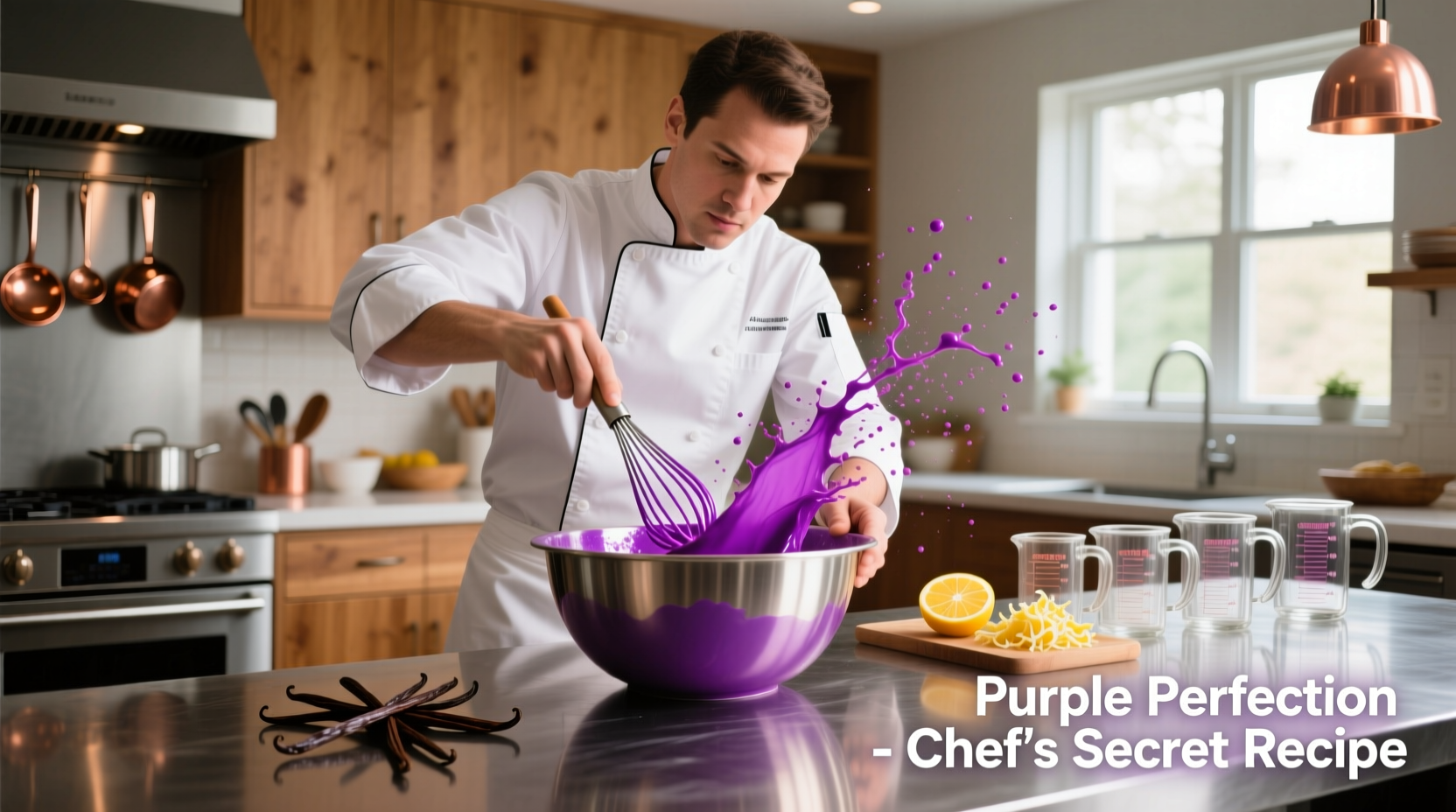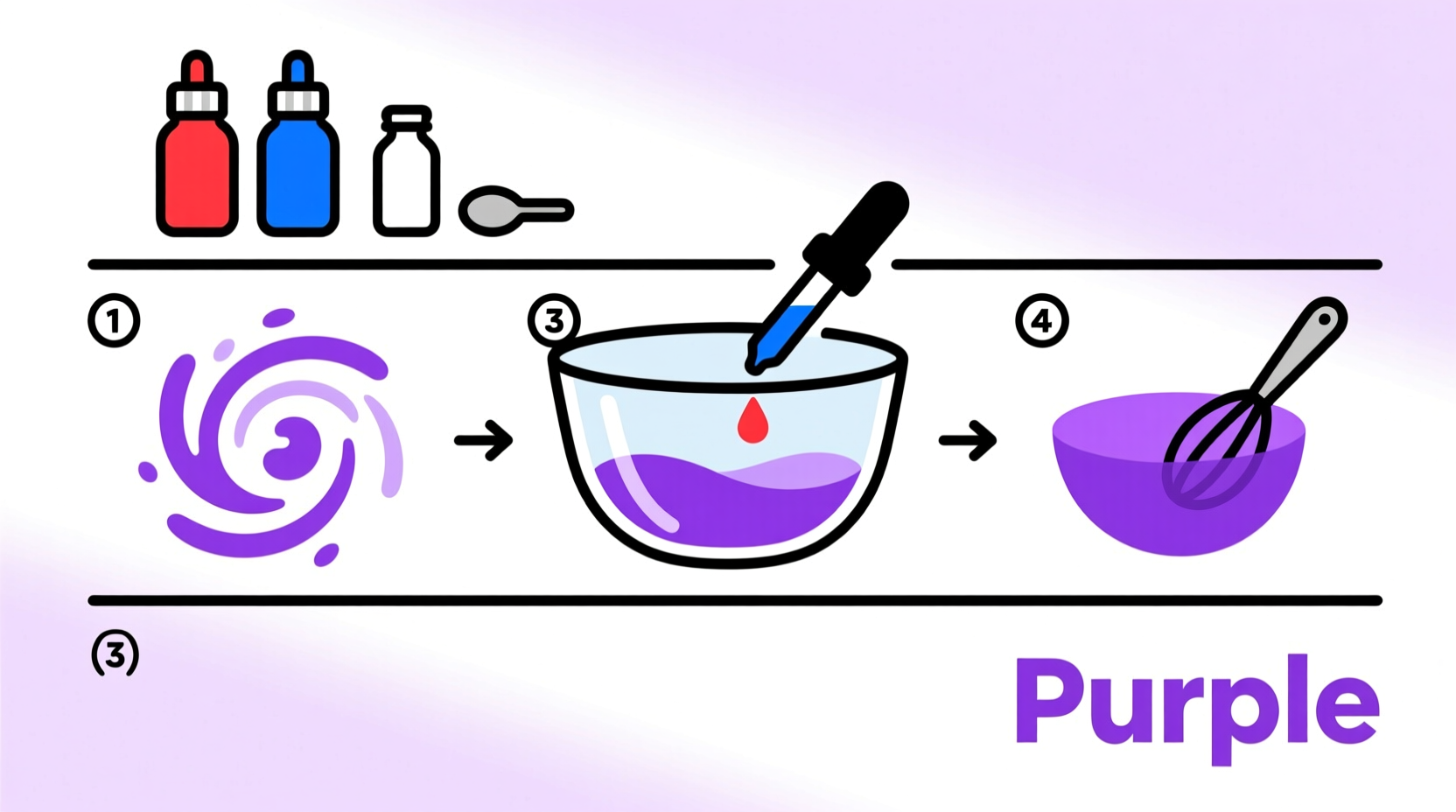The Science Behind Perfect Purple Food Coloring
Creating the ideal purple shade isn't just random mixing—it's color science you can master with precision. When working with food coloring, understanding the relationship between red and blue pigments helps you achieve consistent results every time. Unlike paint, food coloring is translucent, meaning the base color of your batter or icing affects the final outcome. This explains why vanilla cake batter produces different results than chocolate.
Why Your Purple Might Turn Brown (And How to Fix It)
Many home bakers struggle with purple that turns muddy or brown. This happens when the red and blue components aren't properly balanced. Food coloring contains different dye concentrations depending on the brand and type. Professional food scientists at the U.S. Food and Drug Administration note that pH levels in your recipe can also affect color stability—acidic ingredients may shift purple toward pink.
Step-by-Step Purple Creation Process
Follow this professional method used by pastry chefs to create perfect purple shades:
1. Choose Your Food Coloring Type
Gel food coloring produces the most vibrant purples with minimal liquid addition. Liquid coloring requires more drops, potentially affecting recipe consistency. Powdered options work well for dry mixes but can clump if not properly dissolved.
2. Start With the Right Base Ratio
Begin with this foundational ratio for standard purple:
| Purple Shade | Blue Drops | Red Drops | Per Cup of Batter |
|---|---|---|---|
| Basic Purple | 5 | 5 | 10 total drops |
| Lavender | 2 | 3 | 5 total drops |
| Eggplant | 8 | 4 | 12 total drops |
| Fuchsia | 3 | 8 | 11 total drops |
3. Mix Gradually and Test
Add colors incrementally—never pour directly into your entire batch. Mix a small test portion first. Remember that colors deepen as they set, especially in icing. Wait 15 minutes before deciding if you need more coloring.
4. Adjust for Warm or Cool Undertones
For warmer purples (resembling grapes), increase red slightly. For cooler purples (like lavender), add more blue. If your mixture turns brown, add a tiny amount of the color opposite brown on the color wheel—blue.

Practical Applications for Different Recipes
Understanding context boundaries ensures success across various applications:
Baking Applications
Vanilla or white cake batters provide the cleanest canvas for purple. Chocolate recipes require significantly more coloring and often produce burgundy rather than true purple. For cupcakes or layer cakes, add coloring to only half your batter initially, then adjust the second half to create ombré effects.
Icing and Frosting Techniques
Buttercream and cream cheese frostings absorb color differently. American buttercream needs less coloring than Swiss meringue. For gradient effects, divide frosting into portions and color each separately before layering.
Special Considerations for Different Brands
Food science research from USDA National Institute of Food and Agriculture shows significant variation between brands. Wilton gel colors require fewer drops than liquid Americolor. Always check manufacturer guidelines as concentration varies. Professional bakers recommend keeping a color mixing journal specific to your preferred brand.
Troubleshooting Common Purple Problems
When purple goes wrong, these solutions fix 95% of issues:
- Muddy brown result: You've added too much red. Counteract with tiny blue additions (1/4 drop at a time)
- Too pink: Increase blue proportionally. For every 3 drops of red, add 4 drops of blue
- Fades after baking: Use gel coloring and avoid natural colorings which are less stable
- Streaky appearance: Mix coloring with 1 tsp of liquid ingredient first before adding to batter
Advanced Purple Techniques for Professional Results
For bakery-quality results, try these pro methods:
Creating Custom Purple Shades
Add tiny amounts of yellow (1/4 drop) to create plum shades. For lilac, mix in white icing or add milk to lighten. Deep eggplant requires additional blue with minimal red.
Natural Purple Alternatives
While less vibrant, natural options include:
- Beet juice + blueberry juice (creates muted purple)
- Purple sweet potato powder (best for baked goods)
- Butterfly pea flower tea (pH-sensitive, turns purple in acidic environments)
Remember that natural colorings often shift during baking and won't achieve the same vibrancy as artificial options.
Storage and Longevity Tips
Purple food coloring maintains quality for 12-18 months when stored properly. Keep bottles tightly sealed in a cool, dark place. Gel colors separate over time—shake gently before use. Never store near strong-smelling foods as food coloring can absorb odors.
FAQ: Making Purple Food Coloring
Why does my purple food coloring turn brown?
Purple turns brown when red and blue coloring ratios are unbalanced. Too much red creates brown tones. Fix this by adding tiny increments of blue (1/4 drop at a time) until purple emerges. The pH of your recipe also affects color stability—acidic ingredients can shift purple toward pink.
How many drops of food coloring make purple?
Start with 5 drops of blue and 5 drops of red per cup of batter or icing for basic purple. Adjust based on desired shade—lavender needs fewer total drops (2 blue, 3 red), while eggplant requires more (8 blue, 4 red). Always add incrementally and test a small portion first.
Can I make purple with natural food coloring?
Yes, but natural options produce muted shades. Combine beet juice (red) with blueberry juice (blue) for a soft purple. Purple sweet potato powder works well in baked goods. Butterfly pea flower tea creates purple in acidic environments but shifts color with pH changes. Natural colors won't achieve the vibrancy of artificial options and may fade during baking.
What's the difference between gel and liquid food coloring for purple?
Gel coloring provides more vibrant purple with fewer drops, preventing recipe consistency issues. Liquid coloring requires more drops (up to 3x more), which can affect texture. Professional bakers prefer gel for purple shades as it maintains recipe integrity while delivering intense color. Always check brand concentration as ratios vary between manufacturers.
How do I make light purple (lavender) food coloring?
Create lavender by using a 2:3 ratio—2 drops blue to 3 drops red per cup of batter. For lighter shades, reduce total drops to 5 (2 blue, 3 red). In icing, add white coloring or additional buttercream to lighten. Remember that vanilla batter creates warmer lavender while white cake mix yields cooler tones. Test a small portion first as colors deepen over time.











 浙公网安备
33010002000092号
浙公网安备
33010002000092号 浙B2-20120091-4
浙B2-20120091-4